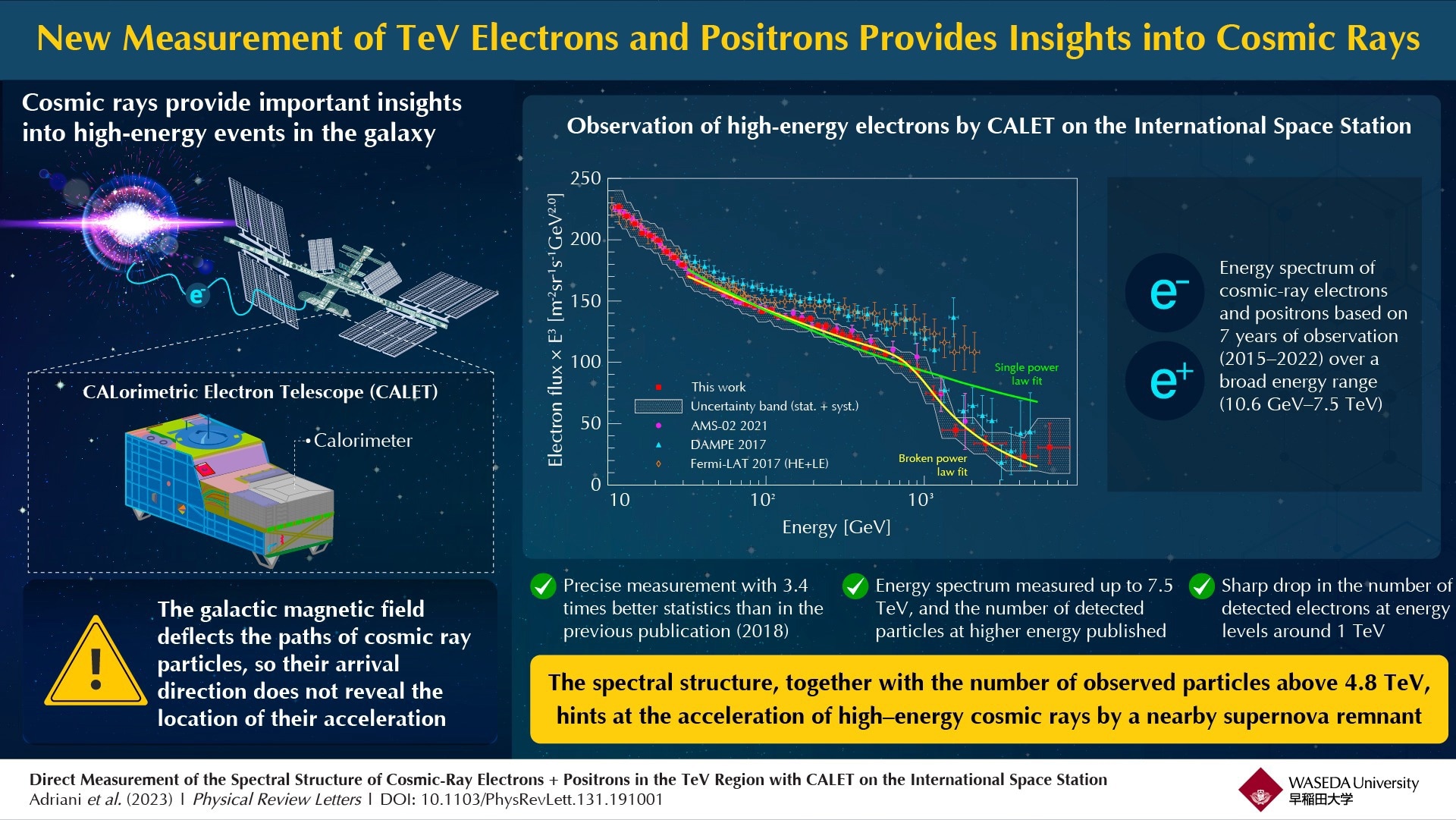The CALorimetric Electron Telescope (CALET) has played a crucial role in detecting cosmic rays, offering insights into high-energy events in the galaxy. In a new study, an international team of researchers has measured the cosmic ray electron spectrum up to an energy of 7.5 TeV for the first time directly in space. The observation is significant since the spectral structure together with the number of observed particles above 4.8 TeV hints at the acceleration of high energy cosmic rays by a nearby supernova remnant.
 The measurement of the energy spectrum of high-energy cosmic-ray electrons and positrons across a broad energy range from 10.6 GeV–7.5 TeV mark a new first. The observation results suggest the possible existence of nearby high-energy cosmic- ray sources. Image Credit: Yosui Akaike from Waseda University, Japan
The measurement of the energy spectrum of high-energy cosmic-ray electrons and positrons across a broad energy range from 10.6 GeV–7.5 TeV mark a new first. The observation results suggest the possible existence of nearby high-energy cosmic- ray sources. Image Credit: Yosui Akaike from Waseda University, Japan
Cosmic rays are high-energy subatomic particles, such as protons, electrons, and atomic nuclei, originating from intense events like supernovae explosions. The study of cosmic rays provides a direct window into the high-energy processes occurring in the universe. However, these particles are deflected by interstellar magnetic fields, complicating efforts to identify their origin, since their direction of arrival does not point back at their sources. To overcome this challenge, scientists turn to observations of high-energy electrons with energies above 1 TeV (1 tera electron volt = 1012 electron volts). Unlike other cosmic ray particles like protons and nuclei, high-energy electrons lose energy rapidly during their journey owing to their low mass. This rapid energy loss means that the electrons reaching Earth are likely to originate from nearby sources.
To understand the origin and propagation of high-energy cosmic rays, the Japan Aerospace Exploration Agency (JAXA), in collaboration with research teams from Italy and the USA, established the CALorimetric Electron Telescope (CALET). Positioned onboard the International Space Station (ISS), CALET tracks the type, energy, and arrival direction of cosmic rays. Using data from the CALET mission, scientists have recently successfully measured the energy spectrum of high-energy electrons in the TeV energy range for the first time directly in space.
In this significant milestone, the CALET team, including Researcher (Associate Professor) Yosui Akaike and Emeritus Professor Shoji Torii from Waseda Research Institute for Science and Engineering at Waseda University, Professor Holger Motz from Global Center for Science and Engineering at Faculty of Science and Engineering at Waseda University, and Assistant Research Scientist Nicholas Cannady from Center for Research and Exploration in Space Science and Technology at NASA Goddard Space Flight Center at Maryland University, Baltimore County, presents observations of high-energy cosmic-ray electrons and positrons across a broad energy range spanning tens of GeVs (giga electron volts) to few TeVs (10.6 GeV-7.5 TeV). Their findings, based on seven years of observations from October 13, 2015, to December 31, 2022, have been published in the journal Physical Review Letters on 09 November 2023.
“We have precisely measured the electron spectrum with CALET for energies up to 7.5 TeV, an energy range never directly observed in space,” states Akaike.
For accurate measurements, the researchers used machine learning techniques to isolate high-energy electrons from background protons. Their efforts resulted in the detection of a large number of electrons and positrons, and the precise measurement of their energy. Based on a number of detected particles 3.4 times larger than used for the previous publication in 2018, a more precise energy spectrum was published, which also extends up to 7.5 TeV in energy compared to 4.8 TeV in the previous publication. Moreover, contrary to a gradual decrease in the flux of high-energy electrons following a simple power law fit, the researchers observed a sudden and significant drop in the number of electrons at around 1 TeV. This drop in the number of high-energy electrons supports the concept that the electrons coming from distant parts of space lose most of their energy during their journey. As a result, only a smaller number of electrons originating from the nearby part of space can arrive at Earth with TeV-range energy, giving the energy spectrum a distinctive downward curve.
The observed energy number of high-energy electrons above 4.8 TeV was found to closely match the prediction of a model for the emission of cosmic rays from the nearby Vela supernova remnant, suggesting it as a potential source for these particles. The detection of particles with such high energies marks a crucial achievement as it can offer a more comprehensive understanding of the universe. The researchers plan on continuing their observations to measure the cosmic ray electron spectrum up to energies of 20 TeV.
“Understanding cosmic rays is not only important regarding their origin and nature but also in relation to observations of X-rays, gamma-rays, and other messengers. Hopefully, this research will reveal many mysteries of the high-energy universe,” says Akaike, highlighting the importance of the CALET mission.